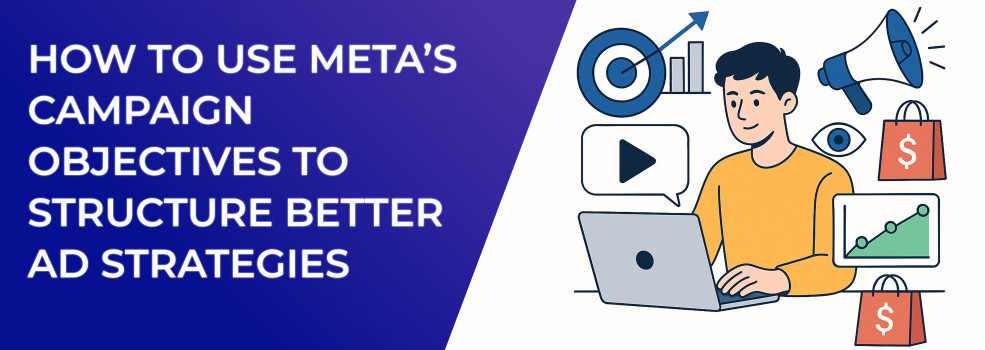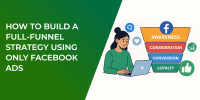Choosing an objective inside Meta Ads Manager might feel like a single tactical step, but in reality it sets the algorithm’s target, shapes auction bidding, and dictates which optimizations even appear in the interface. When that first choice is deliberate, every other adjustment you make later — creative swaps, budget shifts, or campaign budget optimization tweaks — becomes easier and cheaper. The guide below walks through a complete, funnel-aware framework so you can improve Facebook ad performance without guesswork.
1. Why objectives matter and how mismatching hurts results
Meta’s delivery system tries to collect about fifty “optimization events” per ad set during the learning phase. The type of event it hunts for is locked to the objective you choose, which means a single mis-match can starve the algorithm of the signals it needs.
Entering the wrong objective is like asking a sprinter to train for a marathon — it will try, but the results will never look right. Any time costs spike in the first seven days, double-check that the campaign’s declared objective matches the actual business result you expect.
If that red flag appears alongside the notorious “ad set may get zero” warning, this quick-fix guide explains why it happens and how to recover fast → Why You See ‘Ad Set May Get Zero’ on Facebook and How to Fix It.
2. Map objectives to funnel stages instead of vanity metrics
Advertisers often select objectives by gut feel, but aligning them to the customer journey prevents most wasted spend.
For a refresher on sharpening audience definitions before you pick a goal, skim the fundamentals in Facebook Ad Targeting 101: How to Reach the Right Audience.
-
Top of the funnel (TOFU)
Objective: Awareness
Focus KPI: CPM and unique reach
Large, inexpensive audiences teach the pixel which broad interests respond to your message. -
Middle of the funnel (MOFU)
Objective: Traffic or Engagement
Focus KPI: average click-through rate on Facebook ads plus time-on-page
Educational content and soft offers bridge the gap between vague curiosity and real intent to act. -
Bottom of the funnel (BOFU)
Objective: Leads or Sales
Focus KPI: cost per lead (CPL) or purchase-level ROAS
Prospects already know, like, and trust you, so chase hard conversions with social proof and urgency.
Funnel-objective alignment keeps the pixel’s data clean, accelerates exit from learning limited Facebook ads status, and builds remarketing audiences automatically.
3. Hidden features that unlock only with the right objective
Many of Ads Manager’s most powerful levers remain invisible until the correct objective is selected:
-
Advantage campaign budget becomes available inside Sales and Leads campaigns. After roughly a hundred conversions, turn it on so Meta shifts spend toward the cheapest conversion sources without micromanagement.
-
Conversion Lift studies appear only in Sales campaigns and provide statistically sound proof of incremental revenue.
-
Post-engagement custom audiences rely on the Engagement objective; without it you lose a low-cost pool perfect for retargeting pixels downstream.
The Objective dropdown is a master key, using it wisely opens tools you cannot reach any other way. You can find a deeper, step-by-step walkthrough of every objective in Meta Ads Manager in Meta Ad Campaign Objectives Explained: How to Choose the Right One.
4. Benchmarks to track during the first seven days
Meta recommends fifty optimization events per week, but budgets vary. Use these ranges as a compass:
-
CTR for Traffic campaigns: aim for 1.0 – 2.5% in week one
-
CPM for Awareness campaigns: expect about 5 – 12 USD
-
CPL for Lead campaigns: keep at or below 1.5 × your target profit per lead
-
ROAS for Sales campaigns: shoot for 2.0 or higher within 14 days
If ROAS stalls because learning drags on, these tips for finishing the Facebook learning phase quickly will help you hit stability sooner.
Use these performance benchmarks to spot issues early, especially during the first seven days of delivery.
If you drift outside these boundaries by day four, refresh creative first. Constant objective hopping resets learning and erases progress.
5. Budget optimization without starving data
Launching too lean keeps campaigns stuck in learning; overspending hurts profit. Follow this three-step sequence:
-
Begin with a daily budget that can realistically fund fifty optimization events in a week, about 30 USD for BOFU Sales, 150 USD for TOFU Awareness.
-
Once volume stabilizes, activate advantage campaign budget and set the ceiling roughly 25% above your average daily spend so Meta can hunt cheaper conversions across ad sets.
-
When margins are razor thin, introduce a cost-cap bid in Sales campaigns. Delivery may slow briefly, then settle at a sustainable CPA.
When budgets tighten even further, this Facebook Ads Not Converting: How To Fix It checklist walks you through creative and funnel tweaks before you add more spend.
Maintain that order and you’ll enjoy steadier Facebook ad optimization with far less manual juggling.
6. Creative tactics that amplify each objective
The objective tells Meta which users to find; creative tells those users what to feel and do.
-
Awareness: bright branding, motion loops, clear brand cues in the first two seconds
-
Traffic: curiosity headlines, contrast buttons, teaser copy hinting at a lead magnet
-
Engagement: polls, carousel quizzes, short UGC-style videos designed for comments
-
Leads: social proof above the fold, pre-filled instant forms, count-down scarcity
-
Sales: dynamic product ads, review overlays on the first frame, limited-time offers
Creative and objective must speak the same language or the algorithm strains to guess intent.
7. Replace vanity numbers with metrics that steer profit
When teams pull weekly reports, they often drown in surface-level stats — likes, reactions, even simple click counts. Those metrics may look healthy, but they rarely tell you whether money is flowing in or out. To make optimization meetings faster and more decisive, focus on the figures that actually move revenue and trim away the ones that don’t. The table below pairs each campaign objective with a common “vanity” metric that, while interesting, doesn’t predict profitability, and a more meaningful metric that should guide your next round of edits.
Focusing on high-impact metrics turns optimization meetings into ten-minute sprints instead of hour-long debates.
8. Pre-flight checklist before every launch
Treat these questions as a cockpit check and launch with confidence:
-
Does the campaign objective align with the funnel stage you’re targeting?
-
Have you enabled Campaign Budget Optimization where it unlocks?
-
Is your creative matched to the delivery signals for that objective?
-
Did you set benchmark goals for CTR, CPM, or ROAS by day seven?
-
Are the pixel or Conversions API events firing exactly the event tied to the objective?
-
Have you excluded overlapping audiences to prevent fatigue?
Completing this checklist stops most budget leaks before a single impression is served.
Final thoughts
Meta’s campaign objectives are more than simple labels. They instruct a complex prediction engine which results to chase, which tools to reveal, and which levers to ignore. Align each objective with its funnel stage, deploy creative that echoes the desired action, and switch on features like Advantage Campaign Budget after enough data accumulates. Structure campaigns this way and stronger Facebook ad performance becomes less of a gamble and more of a repeatable outcome.

